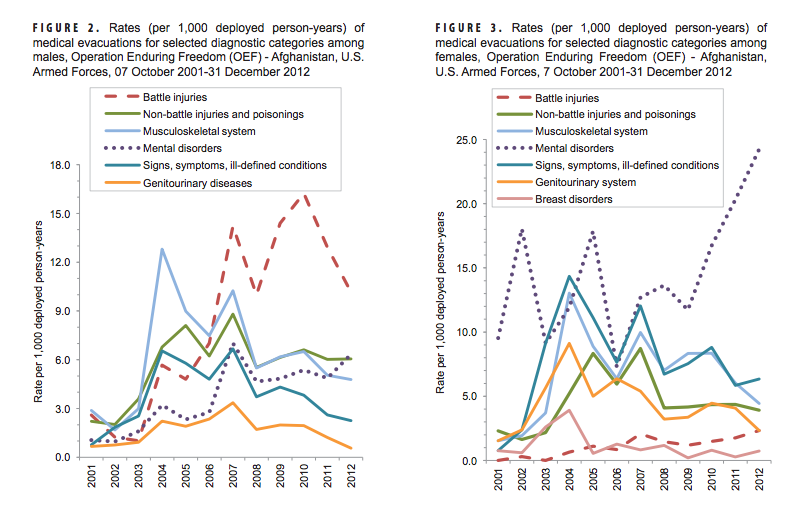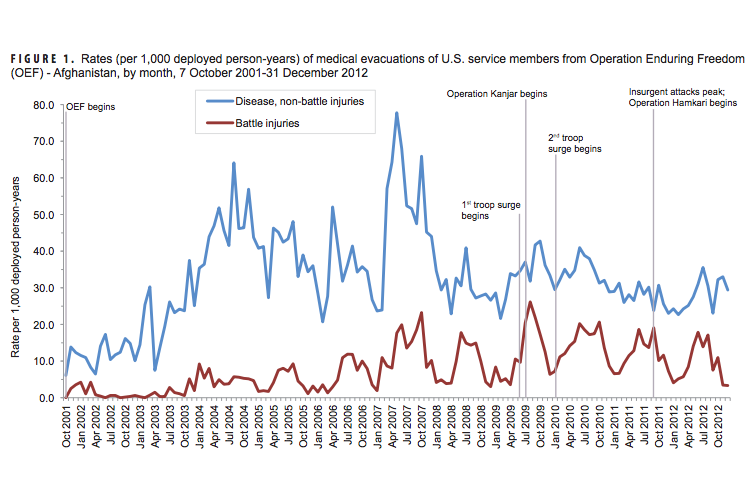U.S. troops in Afghanistan's Pech Valley ready a casualty for a medevac flight last year.
As the U.S. military prepares to send women into the toughest combat billets for the first time, Pentagon medical officers have just released data showing that while “battle injuries” were the leading reason male troops were flown outside Afghanistan for medical care, “mental disorders” topped the list for female troops.
That shouldn’t come as a complete surprise. After all, women remain technically barred from the infantry and other units where close-in combat is the norm. But the data also show that despite the ban, women were medically evacuated from Afghanistan at a rate 22% higher than their male comrades.
The report, which limits itself to a recitation of data, draws no conclusions about why the female evacuation rate was greater, or how that might change as women move closer to the front lines.
But that didn’t stop some from drawing their own conclusions.
“Women in combat zones are enormously valued and respected by their comrades in both Afghanistan and Iraq for physical courage, discipline, personal initiative, and smarts,” says Barry McCaffrey, a retired four-star Army general who commanded a division in 1991’s Persian Gulf War and is father of a Army-major daughter. But, he adds, there are key differences. “In general, women soldiers in good physical condition have much less upper body strength than male soldiers—and are more prone to impact injuries and stress fractures,” he says. “Women soldiers are challenged by some field combat duties such as carrying five-gallon cans of fuel and water, changing armor vehicle track and heavy truck tires, carrying 100-plus-pound loads of ammunition and fighting gear on extended dismounted operations, carrying stretchers of wounded soldiers, and the brute labor required to dig in fighting positions.”
“Women are, on average, less well-suited to the lifestyle of infantry and direct infantry support units,” says William Treseder, who deployed to both Afghanistan and Iraq as a Marine sergeant. At least one female Marine agrees. No woman has been able to pass recent physical-qualification tests for Marine officers.
But others view the findings as a given, in light of the training provided some women. “There is a disgusting and dangerous gap in the type of pre-deployment training afforded males and females in the Marine Corps,” says Lydia Davey, who spent much of 2006-07 in Afghanistan during eight years of service in the corps that ended in 2011 as a sergeant. “I wonder if women fail to adapt to situations they’ve never been trained for….this report can, and probably will, be easily spun to support the conservative agenda against women in combat.”
Medical teams inside Afghanistan handle most wounds, injuries and ailments. “Medical air transports (`medical evacuations’) are costly and generally indicative of serious medical conditions” that cannot be handled in the war zone, the report adds. “Some serious conditions (e.g., battle wounds) are directly related to participation in or support of combat operations; however, many others are unrelated to combat and may be preventable.”
The study, contained in the June issue of the Pentagon’s Medical Surveillance Monthly Report, tracked the 23,719 medical evacuations from the theater among the 1.7 million U.S. deployments between Oct. 7, 2001, the day the U.S. invaded Afghanistan in response to the 9/11 terror attacks, and Dec. 31, 2012.
“During every month of the 11-year period, medical evacuations for disease and non-battle injuries exceeded those for battle-related injuries,” the Pentagon analysis found. “Overall during the period, the rate of evacuations for disease and non-battle injuries was more than triple that of battle-related injuries.”
Battle wounds (5,570 men, 77 women) represented the single largest cause of medical evacuations, followed by musculoskeletal problems (3,074 men, 353 women), non-battle injuries and poisonings (3,159 men, 239 women), and mental disorders (2,408 men, 442 women):
Overall, nearly eight times as many males (n=21,046) as females (n=2,673) were medically evacuated; however, the rate of medical evacuations was 22.0 percent higher among females (46.0 per 1,000 dp-yrs [deployed person-years]) than males (37.7 per 1,000 dp-yrs). Of all medical evacuations of males throughout the period (n=21,046), the most frequent associated diagnoses were battle injuries (26.5%), non-battle injuries (15.0%), musculoskeletal disorders (14.6%), and mental disorders (11.4%). In contrast, the most frequent diagnoses among evacuated females during the period (n=2,673) were mental disorders (16.5%), “signs, symptoms, and ill-defined conditions” (15.3%), musculoskeletal disorders (13.2%), and non-battle injuries (8.9%).
The report says 4% of Army personnel, 2% of Marines, and 1% of Air Force and Navy personnel required medical evacuation from Afghanistan.
“The relatively low likelihood of medical evacuation suggests that most deployers were sufficiently healthy and fit, and most received the necessary medical care in theater to complete their Operation Enduring Freedom assignments successfully,” the analysis concludes. “The findings enforce the need to tailor force health protection policies, training, supplies, equipment, and practices based on characteristics of the deployed force (e.g., combat versus support; male versus female) and the nature of the military operations (e.g., combat versus humanitarian assistance).”




